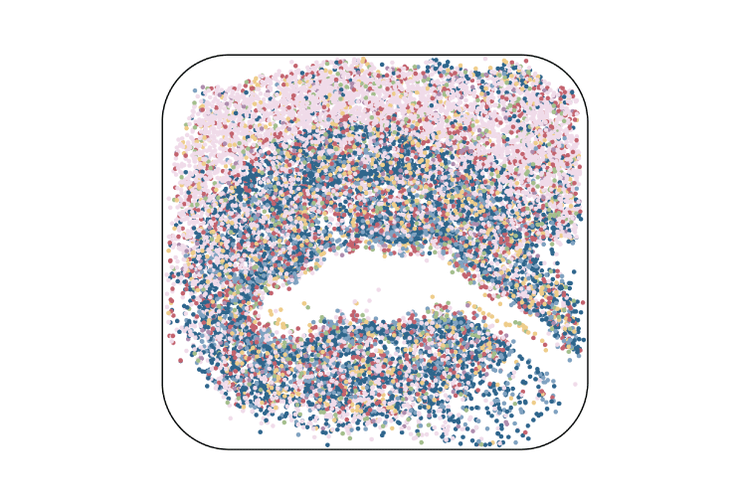
This story originally appeared on the Broad Institute’s website.
When a scientist wants to study individual cells at the molecular level within an organ like the heart or brain, they usually break the tissue up to analyze the cells. This provides rich detail about gene activity, but doesn’t retain information about the cells’ location in the tissue.
Now, scientists can capture both genetic and location information of individual cells using standard single-cell workflows in the lab. A new method developed at the Broad Institute of MIT and Harvard lets researchers attach precise location tags to individual cell nuclei that they can then isolate for a variety of single-cell experiments, while still collecting information about the cells’ original location in tissue.
The new method, known as Slide-tags, was developed by the labs of Fei Chen, a Broad core institute member, a former Merkin Institute Fellow at Broad, and an assistant professor of stem cell and regenerative biology at Harvard University, and Evan Macosko, an institute member in the Stanley Center for Psychiatric Research at Broad and an associate professor at Massachusetts General Hospital. Slide-tags builds on another approach, Slide-seq, which was developed by the same labs and can map spatial patterns of genetic activity within tissues, but doesn’t reach single-cell resolution like the new Slide-tags method.
“With this new approach, we figured out a way for scientists to do all the single-cell experiments that they are already doing while still knowing exactly where a cell comes from,” said Chen. “This is the first time anyone has been able to completely merge the worlds of spatial data and single-cell data.”
The team describes Slide-tags today in Nature and also showed how they used their technique to study cells within tissues including human brain, tonsils, and a melanoma tumor.
“We’ve shown how you can leverage spatial data to discover new biology that you would never turn up if you were just doing standard single-cell experiments,” said Macosko.
“Our experiments go beyond just looking at the genes being expressed in a given cell,” said Andrew Russell, a postdoctoral fellow at Broad and a co-first author on the study. “Slide-tags is compatible with virtually any single-cell sequencing assay, and so brings high-resolution spatial information to single-cell measurements of the cell’s genetic sequence and epigenetic regulation as well.”
Jackson Weir, a graduate student, and Naeem Nadaf, a research scientist, both at the Broad, are also co-first authors on the study.
One cell at a time
Slide-seq, reported in 2019, involves transferring slices of tissue onto arrays of special beads, each one tagged with a DNA barcode that identifies its location in the array. The beads are 10 micrometers in diameter — about the same size as many cells in the body, so most beads only bind to the messenger RNAs from one cell. However, some beads capture the RNA of multiple cells at once. “So it meant that we don’t truly get single cell resolution with Slide-seq,” said Chen.
To overcome this challenge, the Chen and Macosko groups came up with Slide-tags, which uses a similar array of beads, but each bead is tagged with many identical barcodes that indicate the bead’s location. After a tissue slice is applied to the array of beads, the barcodes then seep into the cells’ nuclei. A given nucleus will absorb the highest levels of the barcode belonging to the bead closest to that cell, but also lower levels of the barcodes from beads that are farther away. The researchers then measure the varying levels of different barcodes in each nucleus and calculate the cell’s location within the array.
“Just as a person’s GPS location can be triangulated based on how far they are from multiple different satellites, we can determine the location of any nuclei based on the signal from multiple different beads,” Chen explained.
Location, location, location
Once the barcodes are inside the cell nuclei, researchers can treat the nuclei just as they usually do in standard single-cell experiments.
“The great thing was that once our nuclei were barcoded, we hardly had to make any adjustments at all to the way we usually carry out single-cell experiments,” Nadaf said.
The researchers tested their technique on postmortem human brain samples, which are notoriously hard to use in most spatial assays because the cells degrade quickly after death. The nuclei, however, remained intact much longer, letting Slide-tags work effectively. Macosko’s team labeled slices of the brain tissue and then studied the levels of RNA molecules within each cell to figure out the cells’ identities.
The scientists not only recreated known patterns of cells within the brain cortex, but also discovered clusters of cells that were previously thought to be uniformly distributed around the cortex.
Chen’s group then applied Slide-tags to melanoma tumors and analyzed both cancer cells and immune cells inside the tumors.They discovered that a specific type of immune cell frequently homed in on one region of the tumor that had unique genetic properties. This kind of finding can advance researchers’ understanding of the interplay between immune and cancer cells, which could one day contribute to the development of new immunotherapies.
“Cell-cell interactions within tumors are very complex. Applying Slide-tags at scale to patient samples will help us figure out which specific immune cells are interacting with which cancer cells and why,” Weir said.
The Broad team hopes that other researchers use Slide-tags on their own tissues and cells of interest. They are currently optimizing the technique for use in different tissue types and developing ways to apply it to tissues that have already been fixed, or preserved. They add that this technology will help scientists build large-scale atlases of cell types across entire human organs.
FUNDING:
Support for the study was provided in part by a Merkin Institute Fellowship, the Burroughs Wellcome Fund, the Searle Scholars Program, and an EMBO Postdoctoral Fellowship.
PAPER CITED:
Russell, A.J.. et al. Slide-tags enables single-nucleus barcoding for multimodal spatial genomics. Nature. Online December 13, 2023. DOI: 10.1038/s41586-023-06837-4
